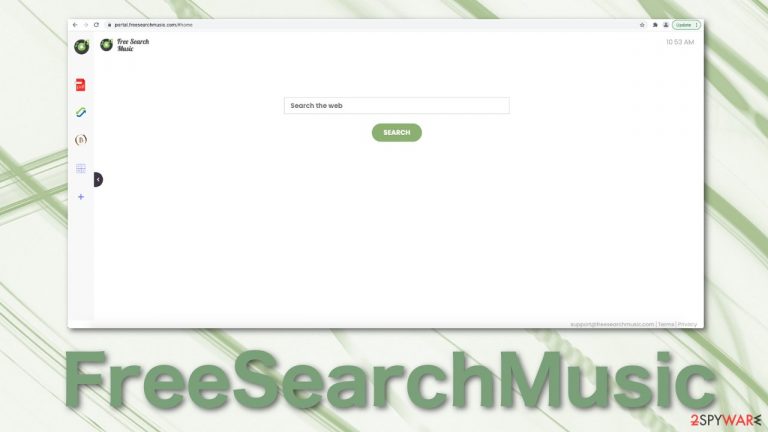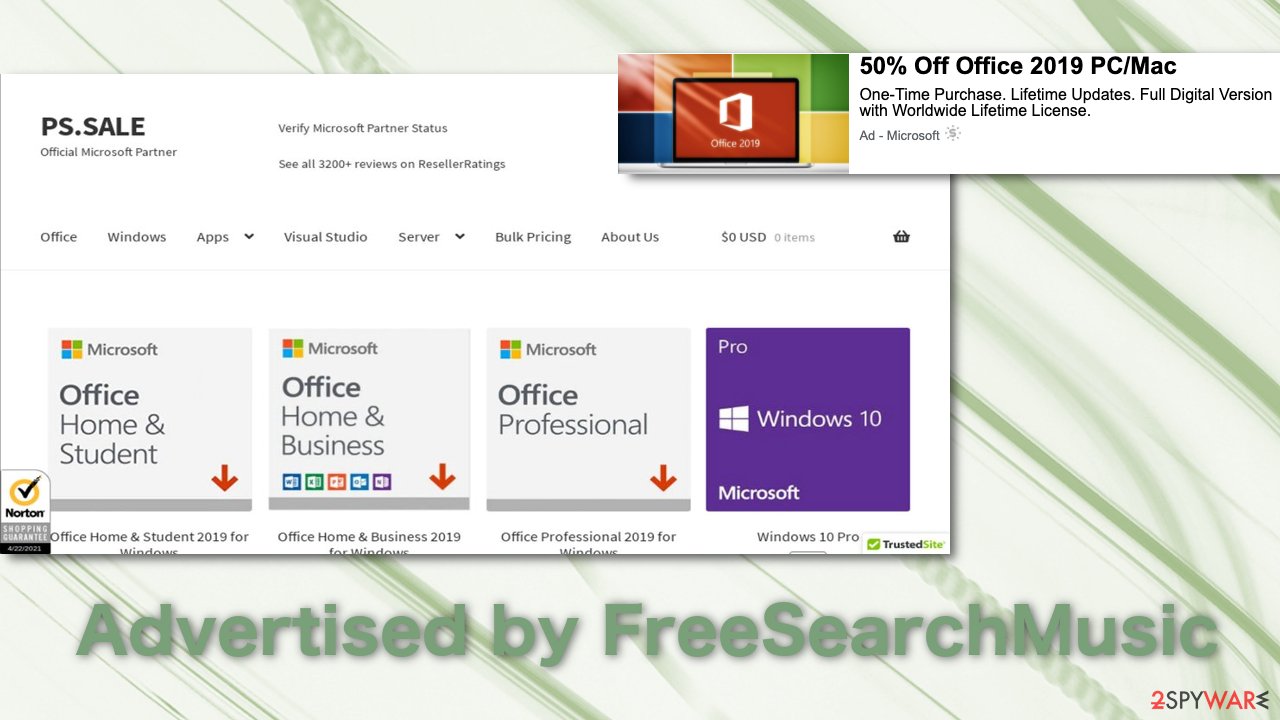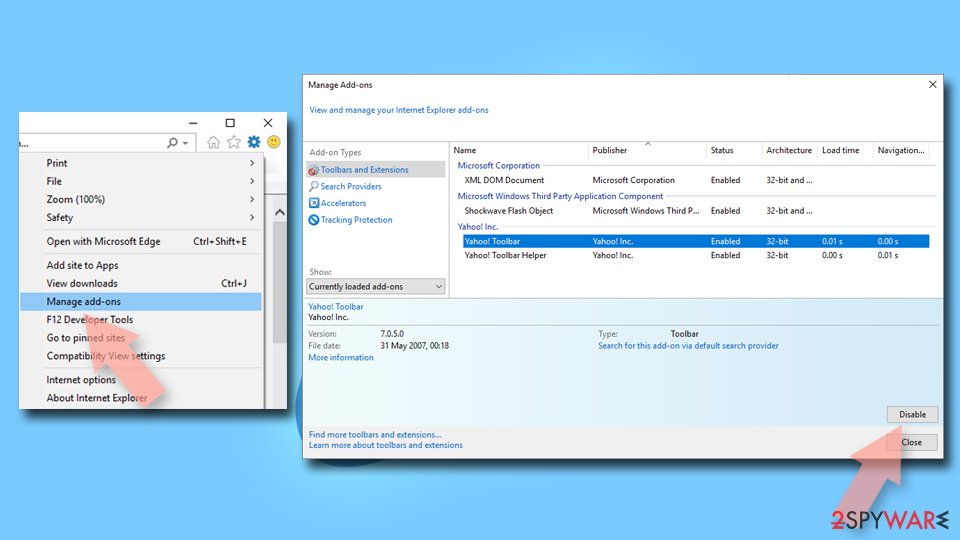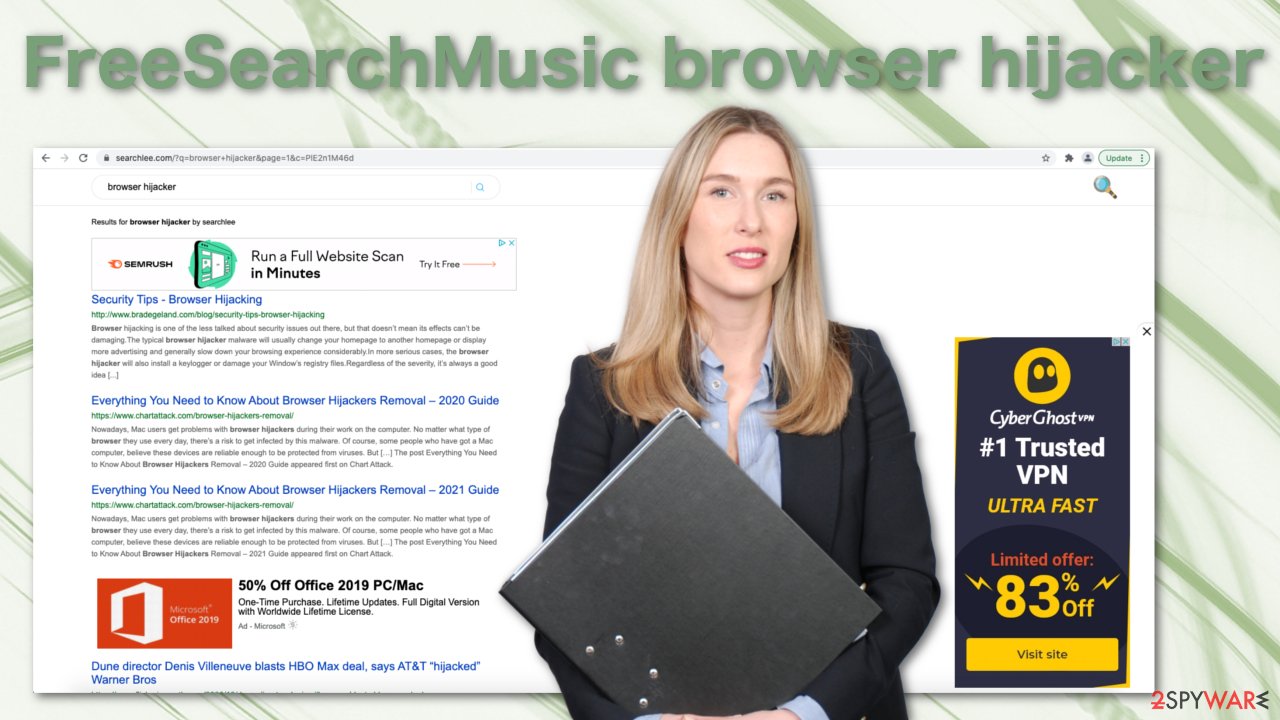FreeSearchMusic browser hijacker (virus) - Free Guide
FreeSearchMusic browser hijacker Removal Guide
What is FreeSearchMusic browser hijacker?
FreeSearchMusic modifies your homepage and displays shady ads

Most browser hijackers are not capable of damaging or stealing your files. Instead, the creators seek to profit from you either by feeding you ads, redirects, or adding useless toolbars. FreeSearchMusic makes it impossible for you to use your browser normally and can open up your computer to a host of additional infections.
The name of the extension indicates that you should be able to find free music through its search engine or something similar. But in fact, it does not have such functions or anything even remotely close to that. Instead, when you type in something in the search it displays results from low-ranked pages which are questionable.
To make itself seem useful, the browser hijacker offers functions that are just a click away in the Google search. This includes a PDF file converter, calculator, currency converter, the ability to save your favorite websites. These are not special and not worth it to in turn get untrustworthy search results.
Another problem with it is the annoying pop-ups all over the screen. They appear in the corners, at the top, between search results. Furthermore, these are sometimes fake websites which we will talk about more later.
| NAME | FreeSearchMusic |
| TYPE | Browser hijacker; potentially unwanted program |
| DISTRIBUTION | Deceptive ads, websites; Bundled software |
| SYMPTOMS | Browsers' settings like the homepage, new tab address, search engine are changed; Advertisements inserted between the search results |
| DANGERS | Altered search results can display misinformation, ads lead to dubious pages |
| ELIMINATION | Remove the unwelcome extension via browser settings |
| FURTHER STEPS | FortectIntego should be used to scan your machine and repair any damage remaining after the removal |
Symptoms to look out for
Browser hijackers are not difficult to identify because of their intrusive nature. They change key settings in your browser like the homepage, new tab address, search engine, and often cause ad spam. Creators of this hijacker are responsible for multiple clones that only differ by names and colors. We already wrote about BestSearchPDF, BestStreamSearch, CheckAMap, and many more. They all redirect users to a couple of different search engines:
- nearbyme.io
- searchlee.com
- Bing
- Yahoo
Browser hijackers rarely have their own search engines as they just use them to function. They do not provide any special results that would be beneficial for the user, so you should not keep these as your default search engines.
One of the most obvious signs of browser hijacking is default homepage change. If your browser displays an unknown website after opening, this is definitely the work of a hijacker. If you enter a URL only to be redirected to a different website than the one you intended to access, it is also an indication of hijacker infection. You can try to change your homepage straight away to your preferred one but once you open your browser again it will probably change back to the hijacked state. The only way to get your settings back to normal is to remove the unwanted program or extension completely.
Hijacked browsers usually display an overwhelming amount of ads. Their main purpose is to generate revenue for the creators every time you click. Advertisements displayed by FreeSearchMusic might lead to websites that are less relevant to you and also promote services/software of dubious nature.
If a message saying that your computer is being hacked or that your security has been compromised appears on your browser or desktop, make sure you read the message carefully before clicking on any links. If the message comes from a program you do not remember having, it is probably the work of a hijacker. Since these messages are intended to look like real system alerts, keep an eye out for any differences – colors, spelling and grammar errors, logo differences.
Just take a look at this ad that popped up while using the browser hijacker:

It really can seem like a legitimate Microsoft ad. After clicking on it, it directed us to a website called PS.SALE. Underneath the title, you can clearly see that it calls itself an “Official Microsoft Partner”.
A popular technique universally employed by unethical e-commerce sites is to develop hidden pages for thousands of items, sell them, and then give no ability for the customer to locate the page ever again after the purchase. Deceitful internet sites construct web pages that cannot be found by utilizing the site search nor by use of Yahoo or Google search engine.
Remember, that Microsoft does not have any partners that sell their digital products like “Office 365”. The only source you can buy them from is the official Microsoft page.[1]
Hijackers' removal
To make your browser go back to its primary state, you will have to remove the add-on manually. Keep in mind that manual removal in the browser settings may not always work because this might be a potentially unwanted program,[2] in which case the process will be a bit more complicated.
Google Chrome
- Open Google Chrome, click on the Menu (three vertical dots at the top-right corner) and select More tools > Extensions.
- In the newly opened window, you will see all the installed extensions. Uninstall all the suspicious plugins that might be related to the unwanted program by clicking Remove.

MS Edge:
- Select Menu (three horizontal dots at the top-right of the browser window) and pick Extensions.
- From the list, pick the extension and click on the Gear icon.
- Click on Uninstall at the bottom.

MS Edge (Chromium)
- Open Edge and click select Settings > Extensions.
- Delete unwanted extensions by clicking Remove.

Mozilla Firefox
- Open Mozilla Firefox browser and click on the Menu (three horizontal lines at the top-right of the window).
- Select Add-ons.
- In here, select unwanted plugin and click Remove.

Safari
- Click Safari > Preferences…
- In the new window, pick Extensions.
- Select the unwanted extension and select Uninstall.

Internet Explorer:
- Open Internet Explorer, click on the Gear icon (IE menu) on the top-right corner of the browser
- Pick Manage Add-ons.
- You will see a Manage Add-ons window. Here, look for suspicious plugins. Click on these entries and select Disable.

Your personal data is at risk
Without putting you in danger of clicking on malicious ads and being worthless, FreeSearchMusic also collects data about your browsing behavior which they can use as they like. You can find this in their Privacy Policy:
By Using the Product, you may enable us or third parties to access, use, and collect a variety of information, regarding your Internet Browser, your browsing habits, and information about your computer including by usage of cookies.
That is why it is important to clean your browsers' cookies and cache frequently to delete any information websites have gathered about you and to improve your devices' performance. This can be made easy with a maintenance tool FortectIntego which can do this automatically. For a manual guide please look below the post.

If it is a PUP
A PUP is an application sometimes disguised as a useful tool but is rarely actually functional. It might have gotten into your system when you were downloading “cracked” software from unofficial sites. Software bundling is a common method to spread apps like this that perform unwanted tasks in the background.
When you download files from third-party websites, often these programs come included as a package. If you rushed through the installation process you might have not even notices them.
Whenever you download freeware,[3] make sure to choose a “Custom” or “Advanced” installation method. Do not skip though the steps, read the Terms of Use, the Privacy Policy and make sure to uncheck the boxes next to the files that are not needed.
Identifying which program is responsible for hijacking your browser might be a little complicated. If you are not sure, we recommend using SpyHunter 5Combo Cleaner or Malwarebytes anti-malware tools that will scan your machine, eliminate it, and prevent such infections in the future. If you still want to do this yourself, here are the steps for Windows and macOS users:
Instructions for Windows 10/8 machines:
- Enter Control Panel into Windows search box and hit Enter or click on the search result.
- Under Programs, select Uninstall a program.

- From the list, find the entry of the suspicious program.
- Right-click on the application and select Uninstall.
- If User Account Control shows up, click Yes.
- Wait till uninstallation process is complete and click OK.

If you are Windows 7/XP user, proceed with the following instructions:
- Click on Windows Start > Control Panel located on the right pane (if you are Windows XP user, click on Add/Remove Programs).
- In Control Panel, select Programs > Uninstall a program.

- Pick the unwanted application by clicking on it once.
- At the top, click Uninstall/Change.
- In the confirmation prompt, pick Yes.
- Click OK once the removal process is finished.
Instructions for Mac machines:
- From the menu bar, select Go > Applications.
- In the Applications folder, look for all related entries.
- Click on the app and drag it to Trash (or right-click and pick Move to Trash)

To fully remove an unwanted app, you need to access Application Support, LaunchAgents, and LaunchDaemons folders and delete relevant files:
- Select Go > Go to Folder.
- Enter /Library/Application Support and click Go or press Enter.
- In the Application Support folder, look for any dubious entries and then delete them.
- Now enter /Library/LaunchAgents and /Library/LaunchDaemons folders the same way and terminate all the related .plist files.

You may remove virus damage with a help of FortectIntego. SpyHunter 5Combo Cleaner and Malwarebytes are recommended to detect potentially unwanted programs and viruses with all their files and registry entries that are related to them.
Getting rid of FreeSearchMusic browser hijacker. Follow these steps
Remove from Microsoft Edge
Delete unwanted extensions from MS Edge:
- Select Menu (three horizontal dots at the top-right of the browser window) and pick Extensions.
- From the list, pick the extension and click on the Gear icon.
- Click on Uninstall at the bottom.

Clear cookies and other browser data:
- Click on the Menu (three horizontal dots at the top-right of the browser window) and select Privacy & security.
- Under Clear browsing data, pick Choose what to clear.
- Select everything (apart from passwords, although you might want to include Media licenses as well, if applicable) and click on Clear.

Restore new tab and homepage settings:
- Click the menu icon and choose Settings.
- Then find On startup section.
- Click Disable if you found any suspicious domain.
Reset MS Edge if the above steps did not work:
- Press on Ctrl + Shift + Esc to open Task Manager.
- Click on More details arrow at the bottom of the window.
- Select Details tab.
- Now scroll down and locate every entry with Microsoft Edge name in it. Right-click on each of them and select End Task to stop MS Edge from running.

If this solution failed to help you, you need to use an advanced Edge reset method. Note that you need to backup your data before proceeding.
- Find the following folder on your computer: C:\\Users\\%username%\\AppData\\Local\\Packages\\Microsoft.MicrosoftEdge_8wekyb3d8bbwe.
- Press Ctrl + A on your keyboard to select all folders.
- Right-click on them and pick Delete

- Now right-click on the Start button and pick Windows PowerShell (Admin).
- When the new window opens, copy and paste the following command, and then press Enter:
Get-AppXPackage -AllUsers -Name Microsoft.MicrosoftEdge | Foreach {Add-AppxPackage -DisableDevelopmentMode -Register “$($_.InstallLocation)\\AppXManifest.xml” -Verbose

Instructions for Chromium-based Edge
Delete extensions from MS Edge (Chromium):
- Open Edge and click select Settings > Extensions.
- Delete unwanted extensions by clicking Remove.

Clear cache and site data:
- Click on Menu and go to Settings.
- Select Privacy, search and services.
- Under Clear browsing data, pick Choose what to clear.
- Under Time range, pick All time.
- Select Clear now.

Reset Chromium-based MS Edge:
- Click on Menu and select Settings.
- On the left side, pick Reset settings.
- Select Restore settings to their default values.
- Confirm with Reset.

Remove from Mozilla Firefox (FF)
Remove dangerous extensions:
- Open Mozilla Firefox browser and click on the Menu (three horizontal lines at the top-right of the window).
- Select Add-ons.
- In here, select unwanted plugin and click Remove.

Reset the homepage:
- Click three horizontal lines at the top right corner to open the menu.
- Choose Options.
- Under Home options, enter your preferred site that will open every time you newly open the Mozilla Firefox.
Clear cookies and site data:
- Click Menu and pick Settings.
- Go to Privacy & Security section.
- Scroll down to locate Cookies and Site Data.
- Click on Clear Data…
- Select Cookies and Site Data, as well as Cached Web Content and press Clear.

Reset Mozilla Firefox
If clearing the browser as explained above did not help, reset Mozilla Firefox:
- Open Mozilla Firefox browser and click the Menu.
- Go to Help and then choose Troubleshooting Information.

- Under Give Firefox a tune up section, click on Refresh Firefox…
- Once the pop-up shows up, confirm the action by pressing on Refresh Firefox.

Remove from Google Chrome
Delete malicious extensions from Google Chrome:
- Open Google Chrome, click on the Menu (three vertical dots at the top-right corner) and select More tools > Extensions.
- In the newly opened window, you will see all the installed extensions. Uninstall all the suspicious plugins that might be related to the unwanted program by clicking Remove.

Clear cache and web data from Chrome:
- Click on Menu and pick Settings.
- Under Privacy and security, select Clear browsing data.
- Select Browsing history, Cookies and other site data, as well as Cached images and files.
- Click Clear data.

Change your homepage:
- Click menu and choose Settings.
- Look for a suspicious site in the On startup section.
- Click on Open a specific or set of pages and click on three dots to find the Remove option.
Reset Google Chrome:
If the previous methods did not help you, reset Google Chrome to eliminate all the unwanted components:
- Click on Menu and select Settings.
- In the Settings, scroll down and click Advanced.
- Scroll down and locate Reset and clean up section.
- Now click Restore settings to their original defaults.
- Confirm with Reset settings.

Delete from Safari
Remove unwanted extensions from Safari:
- Click Safari > Preferences…
- In the new window, pick Extensions.
- Select the unwanted extension and select Uninstall.

Clear cookies and other website data from Safari:
- Click Safari > Clear History…
- From the drop-down menu under Clear, pick all history.
- Confirm with Clear History.

Reset Safari if the above-mentioned steps did not help you:
- Click Safari > Preferences…
- Go to Advanced tab.
- Tick the Show Develop menu in menu bar.
- From the menu bar, click Develop, and then select Empty Caches.

After uninstalling this potentially unwanted program (PUP) and fixing each of your web browsers, we recommend you to scan your PC system with a reputable anti-spyware. This will help you to get rid of FreeSearchMusic browser hijacker registry traces and will also identify related parasites or possible malware infections on your computer. For that you can use our top-rated malware remover: FortectIntego, SpyHunter 5Combo Cleaner or Malwarebytes.
How to prevent from getting browser hijacker
Choose a proper web browser and improve your safety with a VPN tool
Online spying has got momentum in recent years and people are getting more and more interested in how to protect their privacy online. One of the basic means to add a layer of security – choose the most private and secure web browser. Although web browsers can't grant full privacy protection and security, some of them are much better at sandboxing, HTTPS upgrading, active content blocking, tracking blocking, phishing protection, and similar privacy-oriented features. However, if you want true anonymity, we suggest you employ a powerful Private Internet Access VPN – it can encrypt all the traffic that comes and goes out of your computer, preventing tracking completely.
Lost your files? Use data recovery software
While some files located on any computer are replaceable or useless, others can be extremely valuable. Family photos, work documents, school projects – these are types of files that we don't want to lose. Unfortunately, there are many ways how unexpected data loss can occur: power cuts, Blue Screen of Death errors, hardware failures, crypto-malware attack, or even accidental deletion.
To ensure that all the files remain intact, you should prepare regular data backups. You can choose cloud-based or physical copies you could restore from later in case of a disaster. If your backups were lost as well or you never bothered to prepare any, Data Recovery Pro can be your only hope to retrieve your invaluable files.
- ^ Microsoft. Digital Downloads. Microsoft. How To Tell.
- ^ Wikipedia. Potentially unwanted program. Wikipedia. Free Encyclopedia.
- ^ SOC Team. Tales From the SOC: Dealing with the Dangers of Freeware. InfoSecurity Magazine.
